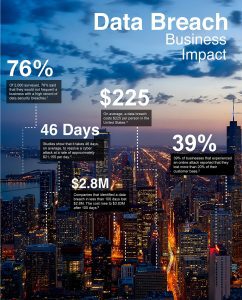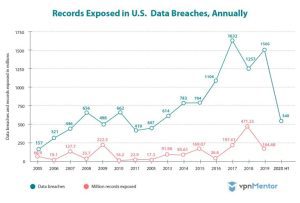
Data: Data breach
A data breach is an incident where information is stolen or taken from a system without the knowledge or authorization of the system’s owner. A small company or large organization may suffer a data breach. Stolen data may involve sensitive, proprietary, or confidential information such as credit card numbers, customer data, trade secrets, or matters of national security.
In today’s digital era, data is vital for business functions, yet it also exposes them to the looming danger of breaches. The aftermath of such incidents extends well beyond the initial impact, haunting businesses for years. Only 51% of data breach costs occur within the first year of an incident. The other 49% happened in year two and beyond.

We will explore the enduring repercussions of data breaches through a real-world case, revealing how a single breach can severely affect a business’s reputation, finances, and compliance status.
The Unseen Costs of a Data Breach
The 2019 cybersecurity breach at First American Title Insurance Co. highlights the extensive repercussions of data breaches. The breach resulted in a $1 million fine imposed by the New York Department of Financial Services in fall 2023 for failing to protect consumer data.
Over 880 million documents containing sensitive personal and financial information were exposed, constituting a severe breach of data protection standards. This case exemplifies how the costs of security incidents can persist long after the initial breach, illustrating how such events can continue to impact businesses for years to come.
Lingering Impacts of a Data Breach
Financial Repercussions
Financial repercussions as a lingering impact of a data breach refer to the long-term financial implications that affect businesses even after the initial breach incident.
Financial repercussions following a data breach persist long after the incident. They encompass fines, legal fees, revenue loss due to damaged reputation and customer trust, expenses for remediation efforts like cybersecurity enhancements, and ongoing costs associated with rebuilding trust and mitigating further risks.
The financial toll of a data breach is significant. Immediate costs include things like:
· Breach detection
· Containment
· Customer notification
Beyond those, businesses face long-term expenses. These relate to legal battles, regulatory fines, and reparations. Regulatory penalties are just one facet of the financial repercussions. Others include potential legal actions from affected individuals, as well as class-action lawsuits adding to the monetary strain.
Reputation Damage
Reputation damage, as a lingering impact of a breach, refers to the long-term harm inflicted on a company’s image and credibility. Customers, investors, and partners may lose trust due to the breach, leading to decreased loyalty, potential loss of business opportunities, and difficulty attracting new customers.
Rebuilding trust and repairing reputation requires extensive efforts in transparency, communication, and demonstrating improved data security measures, which can take years to achieve. These may involve public relations campaigns and enhanced security measures. These actions help assure stakeholders of renewed commitment to data protection.
Regulatory Scrutiny
Regulatory scrutiny refers to the ongoing attention and oversight from regulatory authorities following a data breach. After a breach, regulatory bodies may investigate the incident to determine if the affected organization complied with relevant data protection laws and regulations.
This scrutiny can result in fines, penalties, or other enforcement actions if the organization has failed to perform its duty to safeguard sensitive information. Even after the initial breach, regulatory scrutiny may continue as authorities monitor the organization’s efforts to improve cybersecurity measures and mitigate future risks. This ongoing oversight can have lasting implications for the organization’s reputation, financial stability, and regulatory standing.
Operational Disruption
Operational disruption, as a lingering impact of a breach, refers to the ongoing disturbances and challenges that affect a company’s day-to-day operations. These disruptions can stem from various sources, including implementing new security measures, addressing system vulnerabilities, and restoring customer trust. Such disruptions can lead to a delay in product development, service delivery, and overall business continuity.
Additionally, the need to allocate resources to manage the fallout from the breach can divert attention and resources away from other strategic initiatives, further hampering operational efficiency. Overall, operational disruption following a a breach can persist long after the initial incident, affecting the company’s productivity, agility, and competitive advantage.
A Cautionary Tale for Businesses Everywhere
The repercussions of a breach extend far beyond the immediate incident, which can impact the financial health and reputation of a business for years, as well as its regulatory standing. The frequency and sophistication of cyber threats continue to rise. Proactive cybersecurity measures are not just a necessity. They are a strategic imperative for safeguarding the long-term success of businesses.
The actual cost of a data breach is not always immediately evident. It is a complex interplay of things like:
· Financial penalties
· Reputation damage
· Regulatory Consequences
· Operational disruption
These impacts can persist for years. It is important to learn from real-world examples. Focus on robust cybersecurity measures that help businesses mitigate the risks associated with data breaches, safeguarding their immediate interests and long-term viability.
Need a Cybersecurity Assessment to Prevent an Unexpected Breach?
There are many ways that hackers can breach a network. From endpoints to cloud tools, you must run a tight security ship. Need some help?
Schedule a cybersecurity assessment today. This is the first positive step into understanding and addressing your risk. As well as avoiding the consequences of a data breach.
Need help protecting your business? Get in Touch with Us and See how we can help you.






